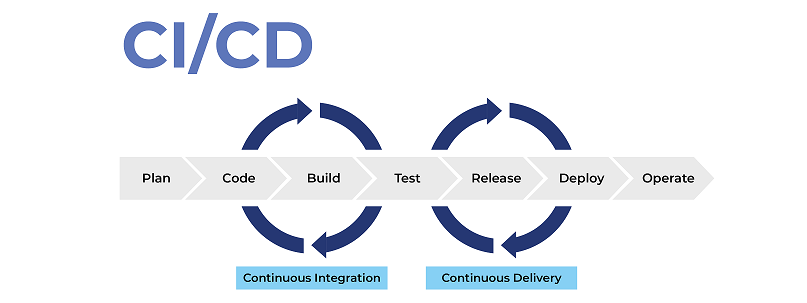The CI/CD concept is an important part of DevOps practice, which enables developers to test and deliver software changes faster and more efficiently. Its meaning is clear when deciphering the abbreviation: Continuous Integration (CI) and Continuous Delivery (CD).
CI/CD terminology and definitions
Continuous integration, CI, is an approach to development characterized by constant minor changes to the code by means of regular commits. Since applications, even within the same team, are developed using different tools and platforms, there is a need for some mechanism that can manage the integration and testing of these changes.

Therefore, the challenge for CI is to establish a consistent and automated way of developing, packaging, and testing the product. By establishing a continuous integration process, developers will make frequent commits, which improves team communication and the quality of the product being developed.
Continuous Delivery (CD) is a kind of continuation of the CI process. It is responsible for automating the deployment of applications across different environments: the live system, the dev environment, and the test environment. If it is necessary to set up specific environment parameters, and query a web server, database, and other services required for the deployment of the application, this is also done with the help of CI/CD tools.
CI/CD also needs continuous testing, which is usually implemented as a set of autotests run in the CI/CD pipeline.
The basic principles of CI/CD
Defining areas of responsibility. A member of the development process is responsible for a specific part of the code, a stage in the product lifecycle. For example, developers and designers handle the business logic and are responsible for the positive UX of the application. Testers introduce end-to-end features and perform acceptance tests. DevOps handle code logistics. End users give feedback when they try to work with the app.
Risk reduction. The CI/CD approach allows greater control over the integrity of the business logic, optimizes data storage and processing, and reduces the risks that arise in product development by a distributed or just a large team.
Quick feedback. Automating code development and testing allows the product to be enriched more quickly with new features. Reducing the number of intermediaries provides quick feedback if problems occur in any area.
User-friendly environment. The development team uses a unified working environment for version control and auxiliary branches responsible for the quality, scalability, and fault tolerance of the product. The tested code is transferred to the main branch and tested there as a part of a single solution.
Some teams adopting the CI/CD methodology and working in the cloud use containers like Docker, and orchestration solutions, usually Kubernetes. Containerization technologies allow the process of packaging and delivering code to the common view, simplify scalability, and quickly remove working environments with inconsistent workloads.
CI/CD stages
The CI/CD concept divides the development process into seven stages:
-
Coding. Developers write their part of the code and manually test it. The written module is then sent to the main branch with the current version of the product. After all the submitted modules are published in the main branch, the second stage begins.
-
Building. The version control system used in the team performs automatic build and testing of the entire product code. The build can start either on command or automatically, following the previously set trigger.
-
Manual testing. After the autotests, a tester examines the code.
-
Release. Once testing is complete and final fixes have been made to the code, it's time to release the client version.
-
Deployment. A working version of the project is deployed to the developer's live server. Users can interact with the product and are acquainted with the new features.
-
Maintenance and monitoring. The clients start using the application, and the developers monitor the user experience and maintain the product.
-
Planning. After analyzing the user experience, developers offer new features and prepare a plan for improvements. This is followed by the first stage of the cycle, code writing.
Benefits of continuous integration-continuous deployment (CI/CD)

The CI/CD concept has a number of advantages that have made it popular in the developer community. What are these benefits?
Reduced time-to-market. Development speeds up, with necessary changes being made in days (or weeks for complex projects). Without CI/CD, deadlines can take months. Developers are able to test and roll out application updates faster, ahead of the competition.
Testing capability. The developer can test the code faster by performing more iterations. This makes it easier to filter out unsuccessful or inappropriate code in the early stages, focusing on the more promising ones.
Higher quality. Combining self-tests and manual testing delivers higher code purity while protecting from late-stage bugs. Reduces the risk of an unpleasant bug being discovered during release, causing the project to freeze.
However, CI/CD has some disadvantages too. For example, high requirements for experience. All developers must understand the concept and have the skills to switch to the new concept. There is also some complexity in terms of the constant coordinated interaction of the development team. Ideally, there should be a person who establishes communication within the team.
The CI/CD tools are changing all the time, so there is no sense in enumerating them here. The only ones that stand out are GitLab and Jenkins, considered to be almost basic developer tools.



